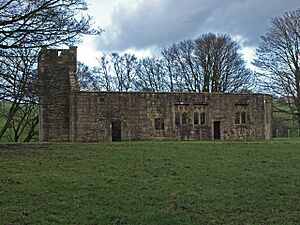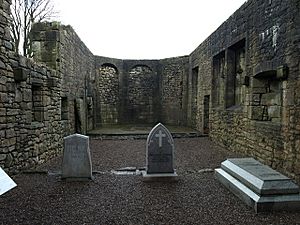Castle Semple Church facts for kids

Castle Semple Collegiate Church is an old church found in Renfrewshire, Scotland. It sits near the eastern end of Castle Semple Loch, inside Clyde Muirshiel Regional Park. The church is about 2 miles (3.2 km) west of Howwood. This old Gothic church is protected by Historic Environment Scotland as a special historic site.
Contents
History of Castle Semple Church
Building the Church
John Sempill, 1st Lord Sempill started this church around the year 1504. It was built near his home, Castle Semple. This church was a "collegiate church," which meant it had a group of priests and helpers. It had a leader called a provost, six chaplains, two boys, and a sacristan.
Royal Visits and Early Days
King James IV of Scotland visited John Sempill's home and the new church on July 26, 1505. The king even gave a gift of 14 shillings to the "New College." A stone on the outside wall of the church has the letters R. L. S. carved into it. It also shows the family symbols of Sempill and Montgomerie.
Church Features and Age
The church is about 71.5 feet (21.8 meters) long. It is 24.25 feet (7.4 meters) wide and 15.5 feet (4.7 meters) tall. Today, its walls are covered with ivy. The roof was taken off in the 1800s, and the ivy has grown inside. Long ago, there might have been a village here. There was also a small chapel nearby, dedicated to St. Bride.
Design and Architecture of the Church
Church Shape and Windows
The church building is a simple rectangle. At its east end, it has a three-sided shape called an apse. A square tower sticks out from the middle of the west wall. The double windows show a very late style of Gothic architecture. Other windows on the side walls have been changed over time.
Special Carvings and Symbols
Above the door leading to the main part of the church, called the chancel, are two coats of arms. These carvings have the letters R. L. S. and A. M. S. One shield shows the Sempill family symbol. The other shield shows the Montgomerie family symbol.
Tower and Interior Layout
The square tower at the west end is very plain. The tower and most of the side walls were built around the time the church was first started. The east apse was added later, in the 16th century. It was built to hold the monument of John, Lord Sempill. He died in the Battle of Flodden in 1513. You can still see some parts of the original square-shaped windows on the side walls.
Inside the Church
The inside of the church was divided into three separate areas by two strong walls. These areas were used as private burial places. In the eastern part, there is a large monument for Lord Sempill. In the middle part, there is a stone slab. This slab remembers Gabriel Sempel, who passed away in 1587.



